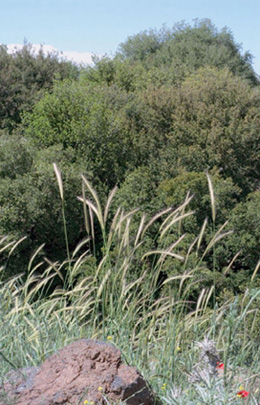

At one time, acorns were widely utilized for food. In March, near Mayas, Syria.
OAK IS ONE OF A GROUP OF BIBLE trees that are well known outside western Asia. The prominence and familiarity of oak in Europe could be the reason that some translations use the word “oak” to simply mean large trees.
Two oaks grow widely in the Middle East, Quercus calliprinos and Q. ithaburensis, though they are not distinguished from each other in the scriptures. Both can be large, long-lived trees with spreading branches. Because of extensive overgrazing and cutting, large oaks are uncommon in the region today. With their size, longevity, and beauty, it is easy to see why oaks are objects of veneration throughout the world.
As with other large trees, both the oak and the cedar can be a symbol of a mighty man. Several such references are made in the Bible: “Yet it was I who destroyed the Amorite before them, he was as tall as the cedars, as strong as the oaks” (Amos 2:9a, NJB).
Ancient oaks were used for purposes other than timber, including nutrition. The acorns of Quercus calliprinos and Q. ithaburensis, the oaks that are common in the Levant, are edible, although some trees produce extremely bitter acorns. In some regions, acorns were an important food source because of their high starch content and storability. As recently as 2002, I saw acorns sold by a street vendor in Damascus.

“Wail, oaks of Bashan; the dense forest has been cut down!” (Zechariah 11:2b). The oaks of this region have less to wail about since the establishment of an oak preserve near Suweida, Syria. This oak is Quercus calliprinos. The grass in the foreground is a wild barley, Hordeum bulbosum.

Large, open-grown Quercus ithaburensis in degraded forest near Ajlon, Jordan. Because of the paucity of wood for building and fuel in the Middle East, most of the large trees there were felled long ago.
Only a fraction of the original oak forests in the Middle East remain because of cutting and overgrazing. The most recent insult was the use of oak for fuel for Ottoman locomotives to maintain the essential Hejaz Railway at the time of the First World War, which decimated the oaks of Bashan.
At one time, the Hauran region, including part of southeastern Syria, was famous for its oaks, the oaks of Bashan mentioned in the Bible: “From oaks of Bashan they made your oars” (Ezekiel 27:6a, NJB). In the early eleventh century, an Arab traveler by the name of Mukaddasi visited the Hauran region and wrote that the natives subsisted on acorns that they ground and mixed with “desert barley” (which I take to be Hordeum spontaneum) (le Strange 1896). This report indicates that oaks were abundant in the Hauran at one time, and that the oaks of Bashan are less abundant than in previous centuries.
Oak makes excellent charcoal. Even though the forest preserves in Jordan prohibit cutting and burning of trees, I have seen “charcoal poaching” near the Zubia Preserve in Jordan, indicating the continuing value of this wood for fuel.